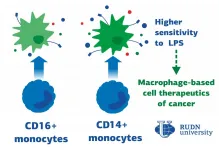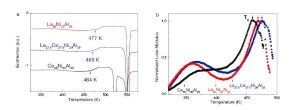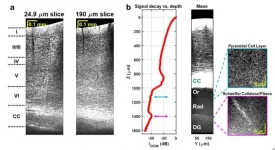(Press-News.org) A new way of producing coherent light in the ultra-violet spectral region, which points the way to developing brilliant table-top x-ray sources, has been produced in research led at the University of Strathclyde.
The scientists have developed a type of ultra-short wavelength coherent light source that does not require laser action to produce coherence. Common electron-beam based light sources, known as fourth-generation light sources, are based on the free-electron laser (FEL), which uses an undulator to convert electron beam energy into X-rays.
Coherent light sources are powerful tools that enable research in many areas of medicine, biology, material sciences, chemistry and physics.
This new way of producing coherent radiation could revolutionise light sources, as it would make them highly compact, essentially table-top size, and capable of producing ultra-short duration pulses of light, much shorter than can be produced easily by any other means.
Making ultraviolet and X-ray coherent light sources more widely available would transform the way science is done; a university could have one of the devices in a single room, on a table top, for a reasonable price.
The group is now planning a proof-of-principle experiment in the ultraviolet spectral range to demonstrate this new way of producing coherent light. If successful, it should dramatically accelerate the development of even shorter wavelength coherent sources based on the same principle. The Strathclyde group has set up a facility to investigate these types of sources: the Scottish Centre for the Application of Plasma-based Accelerators (SCAPA), which hosts one of the highest power lasers in the UK.
The new research has been published in Scientific Reports, one of the Nature family of journals.
Professor Dino Jaroszynski, of Strathclyde's Department of Physics, led the research. He said: "This work significantly advances the state-of-the-art of synchrotron sources by proposing a new method of producing short-wavelength coherent radiation, using a short undulator and attosecond duration electron bunches.
"This is more compact and less demanding on the electron beam quality than free-electron lasers and could provide a paradigm shift in light sources, which would stimulate a new direction of research. It proposes to use bunch compression - as in chirped pulse amplification lasers - within the undulator to significantly enhance the radiation brightness.
"The new method presented would be of wide interest to a diverse community developing and using light sources."
In FELs, as in all lasers, the intensity of light is amplified by a feedback mechanism that locks the phases of individual radiators, which in this case are "free" electrons. In the FEL, this is achieved by passing a high energy electron beam through the undulator, which is an array of alternating polarity magnets.
Light emitted from the electrons as they wiggle through the undulator creates a force called the ponderomotive force that bunches the electrons - some are slowed down, some are sped up, which causes bunching, similar to traffic on a motorway periodically slowing and speeding up.
Electrons passing through the undulator radiate incoherent light if they are uniformly distributed - for every electron that emits light, there is another electron that partially cancels out the light because they radiate out of phase. An analogy of this partial cancelling out is rain on the sea: it produces many small ripples that partially cancel each other out, effectively quelling the waves - reducing their amplitude. In contrast, steady or pulsating wind will cause the waves to amplify through the mutual interaction of the wind with the sea.
In the FEL, electron bunching causes amplification of the light and the increase in its coherence, which usually takes a long time - thus very long undulators are required. In an X-ray FEL, the undulators can be more than a hundred metres long. The accelerators driving these X-ray FELs are kilometres long, which makes these devices very expensive and some of the largest instruments in the world.
However, using a free-electron laser to produce coherent radiation is not the only way; a "pre-bunched" beam or ultra-short electron bunch can also be used to achieve exactly the same coherence in a very short undulator that is less than a metre in length. As long as the electron bunch is shorter than the wavelength of the light produced by the undulator, it will automatically produce coherent light - all the light waves will add up or interfere constructively, which leads to very brilliant light with exactly the same properties of light from a laser.
The researchers have demonstrated theoretically that this can be achieved using a laser-plasma wakefield accelerator, which produces electron bunches that can have a length of a few tens of nanometres. They show that if these ultra-short bunches of high energy electrons pass through a short undulator, they can produce as may photons as a very expensive FEL can produce. Moreover, they have also shown that by producing an electron bunch that has an energy "chirp", they can ballistically compress the bunch to a very short duration inside the undulator, which provides a unique way of going to even shorter electron bunches and therefore produce even shorter wavelength light.
INFORMATION:
The research collaboration also involved the University of Manchester, Pulsar Physics in the Netherlands and the STFC ASTeC group at Daresbury Laboratories. The study has received funding from the EPSRC (Engineering and Physical Sciences Research Council), to support a project named Lab in a Bubble.
In the field of industrial engineering, using simulations to model, predict and even optimise the response of a system or device is widespread, as it is less expensive and less complex -and, sometimes, less dangerous- than fabricating and testing several prototypes.
This type of simulation studies uses numerical methods that, depending on the problem to be addressed -for example, reducing the aerodynamic forces of an aircraft by changing its shape or using the minimum possible amount of material on elements under loading without breaking- require the simulation of a wide variety of possible combinational cases, which entails high computational costs.
The researchers from the School of Industrial Engineering of the University of Malaga Francisco Javier Granados Ortiz ...
Neuro-evolutionary robotics is an attractive approach to realize collective behaviors for swarms of robots. Despite the large number of studies that have been devoted to it and although many methods and ideas have been proposed, empirical evaluations and comparative analyses are rare.
A publication in the journal Nature Communications, led by Mauro Birattari and his team at the research center IRIDIA, École Polytechnique de Bruxelles, Université Libre de Bruxelles, compares some of the most popular and advanced neuro-evolutionary methods for offline design of robot swarms.
"Concretely, these ...
RUDN University biologists discovered the way how macrophages (the cells of the "first line" immune response) respond to inflammation and identified how the immune response depends on their origin. It turned out that when exposed to an inflammatory stimulus, two opposing mechanisms are activated in macrophages simultaneously -- inducing and inhibiting inflammation. These data can potentially be useful in the treatment of cancer, as targeted activation of macrophages will strengthen the immune response of the organism in the fight against a tumor. The results were published in the journal Biomedicine & Pharmacotherapy.
Macrophages are the cells responsible for phagocytosis -- they capture bacteria, the dead cells remains ...
A collaborative group from Tohoku University and Johns Hopkins University have provided valuable insights into the glass transition.
When a liquid is cooled rapidly, it gains viscosity and eventually becomes a rigid solid glass. The point at which it does so is known as the glass transition.
But the exact physics behind the glass transition, and the nature of glass in general, still pose many questions for scientists.
Metallic Glasses (MGs) are highly sought after since they combine the flexibility of plastic with the strength of steel. They are amorphous materials with a disordered atomic structure and exhibit unique and divergent thermodynamic ...
Neuromodulation at high spatial resolution has been an invaluable approach for treating neurological diseases and advancing fundamental knowledge in the field of neuroscience, as firing of a small population or even single neurons can specifically alter animal behavior or brain state. Optogenetics is a powerful method capable of modulating population neural activity in rodents, yet its requirement for viral transfection limits its applications in nonhuman primates and humans. As a rapidly growing modality, focused ultrasound has been harnessed in a myriad of brain neuromodulation applications. However, conventional piezo-based transducers offer a spatial resolution of several millimeters. It is also challenging ...
JULY 15, 2021, NEW YORK - A Ludwig Cancer Research study has found that inducing random chromosome instability (CIN) events in mice for as little as one week is enough to trigger harmful chromosomal patterns in cells that spur the formation of tumors.
"We show that you don't need chronic, lifelong chromosomal mistakes to produce tumorigenesis at a quite respectable frequency," said Don Cleveland, Member of the Ludwig Institute for Cancer Research, San Diego, who led the study with Floris Foijer of the University of Groningen, in The Netherlands. "A very transient exposure would likely be sufficient to drive a very substantial increase in tumorigenesis."
The finding, detailed this week in the journal END ...
Washington, DC / New Delhi, India - Researchers at CDDEP recently published 'Improving vaccination coverage and timeliness through periodic intensification of routine immunization: evidence from Mission Indradhanush' where they evaluated the performance of India's Mission Indradhanush (MI) child vaccination campaign -- a periodic intensification of the routine immunization program.
Each year, 1.2 million Indian children die, accounting for a fifth of global under-5 deaths. Over 400,000 of these deaths are from vaccine-preventable diseases. An estimated 38% of Indian children under the age of two years were not-fully-immunized in 2016. Additionally, vaccinated children received 23%-35% of the doses of polio, diphtheria-pertussis-tetanus ...
Main points
Strong evidence that patients with pre-existent mental disorders are twice as likely to die or be hospitalised after SARS-CoV-2 infection
Psychotic and mood disorders are linked with COVID-19-associated mortality, as are exposure to antipsychotic and anxiolytic treatments.
Patients with substance use disorders are at increased risk of hospitalisation.
In the largest systematic review and meta-analysis to date on COVID-19 outcomes in individuals with psychiatric disorders, the odds of dying or being hospitalized following COVID-19 ...
The team's findings, with important implications for ocean biogeochemistry and climate science, have been published by Nature Communications in a paper by Associate Professor Mark Holzer from UNSW Science's School of Mathematics & Statistics, with co-authors Tim DeVries (UCSB) and Casimir de Lavergne (LOCEAN).
"The deep North Pacific is a vast reservoir of remineralized nutrients and respired carbon that have accumulated over centuries," says A/Prof. Holzer. "When these deep waters are returned to the surface, their nutrients support biological production and their dissolved CO2 can be released into the atmosphere. As such, the deep Pacific plays a key ...
Central nervous system (CNS) diseases such as Alzheimer's disease (AD) manifest early at the microscopic (i.e. cellular) level, deep in the brain. Yet, optical microscopes that can see cells in the living brain are superficial or invasive. Whole brain imaging techniques such as magnetic resonance imaging are deep and non-invasive, but lack cellular resolution.
In a new paper published in Light Science & Application, a team of scientists, led by Professor Vivek J. Srinivasan from the Departments of Ophthalmology and Radiology and Tech4Health Institute, ...




